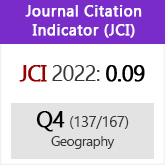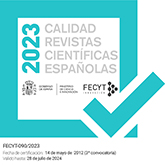The cadastre in southern Italy: a centuries-old presence (from the 15th to the 18th century)
DOI:
https://doi.org/10.3989/estgeogr.2023142.142Keywords:
Cadastre, Southern Italy, local finance, tax based on cadastral register, regulatory contest, current practiceAbstract
This study aims to investigate the presence of cadastres in municipal finance in the 16th-17th centuries, a time when indirect taxes such as duties and gabelle had become prevalent, and census surveys were longer necessary for assessment purposes. The Kingdom of Naples, in southern Italy, was chosen as a case study due to the wealth of documentary sources still available for studying local finance. The focus of the study is the land registers of the 15th-17th centuries to try to define how they were made at the local level before the reform ordered by Charles of Bourbon in the 1740s and aims to understand how wealth was assessed, the tax base was used, and the collection mechanisms employed. Our investigation includes all the cadastral documents that can help answer these questions, without relying on a single case study as the definitive model for an entire system. The method adopted is the comparative one which takes advantage of the comparison between cases and cadastral models both the ancient ones and those of the reform of Charles of Bourbon. The key to understanding the research lies in the relationship between law and practice, especially the interplay between the laws codified by the Government through pragmatica laws, edicts, and instructions, on the one hand, and cadastral practices in force at the municipal level during a period when local particularism could benefit from sovereign respect for the customs of communities.
Downloads
References
Ardant, A. (1984). Politica finanziaria e struttura economica degli stati nazionali moderni. In C. Tilly (Ed.), La formazione degli stati nazionali nell'Europa occidentale (pp. 153-226). Bologna, Italia: Il Mulino.
Bonney, R. (1995). Revenues. In R. Bonney, Economic Systems and State Finance. Oxford-New York, Great Britain-United States: Oxford University Press. https://doi.org/10.1093/oso/9780198205456.001.0001 PMCid:PMC2607734
Brian, E. (1994). La mesure de l'Etat. Administrateurs et géomètres au XVIIIe siècle. Paris: Albin Michel.
Buck, P. (1982). People who counted: political arithmetic in the eighteenth century. In ISIS, International review devoted to the History of Science and its cultural influences, vol. 73, n. 266, pp. 28-45. https://doi.org/10.1086/352907
Bulgarelli Lukacs, A. (1993). L'imposta diretta nel Regno di Napoli in età moderna. Milano, Italia: FrancoAngeli.
Bulgarelli Lukacs, A. (2008). The fiscal system in the Kingdom of Naples. Tools for Comparison with the European Reality (13th-18th Centuries). In S. Cavaciocchi (Ed.), La fiscalità nell'economia europea, secc. XIII-XVIII (pp. 241-258), Atti delle settimane di studi "F. Datini". Firenze, Italia: Firenze University Press.
Bulgarelli Lukacs, A. (2012a). La finanza locale sotto tutela. Regia Corte e comunità nel Regno di Napoli (secolo XVII). Venezia, Italia: Marsilio.
Bulgarelli Lukacs, A. (2012b). La finanza locale sotto tutela. I bilanci delle comunità nel Regno di Napoli (secoli XVII-XVIII). Venezia, Italia: Marsilio.
Bulgarelli Lukacs, A. (2003). La génesis del Catastro en el reino de Nápoles. In CT Catastro, n. 49, pp. 35-56.
Bulgarelli Lukacs, A. (2014-2015). Tax Evasion and Tax Avoidance in the Towns of the Kingdom of Naples (XV-XVIII Centuries). In Baetica: estudios de Arte, Geografía e Historia, 36-37, pp. 49-71. https://doi.org/10.24310/BAETICA.2015.v0i36-37.161
Bulgarelli Lukacs, A. (2021). Le grandi inchieste sulla finanza locale. Il caso del Regno di Napoli tra XVI e XVIII secolo. In Proposte e ricerche. Economia e società nella storia dell'Italia centrale, (87), pp. 73-73-97.
Bulgarelli Lukacs, A. e Carboni, M. (2016). Un protagonista introvabile: la finanza locale italiana in età moderna. In RiSES - Ricerche di Storia Economica e Sociale (1-2), pp. 7-29.
Caldora, U. (1960). Calabria napoleonica, Napoli: F. Fiorentino.
Carboni, M. (2008). Stato e finanza pubblica in Europa dal medioevo a oggi. Un profilo storico. Torino, Italia: Giappichelli.
Cervellino, L. (1686). Direzione ovvero guida delle Università di tutto il Regno di Napoli per la sua retta amministrazione. Napoli: Gio. Francesco Paci.
Ciaraldi, D. (1795). Sopra i difetti del catasto del Regno paragonato al censo che praticarono i Romani per la giusta distribuzione di pubblici pesi. Napoli: Orsino.
Dal Pane, L. (1936). Studi sui catasti onciari del regno di Napoli, Minervino Murge (1743), Bari:
De Lorenzo, R. (1984). Proprietà fondiaria e fisco nel Mezzogiorno: La riforma della tassazione nel decennio francese 1806-1815, Salerno, Poligraf, 1984.
De Lorenzo, R. (2003). I catasti napoleonici nel Mezzogiorno d'Italia tra strumento fiscale e rappresentazione cartografica. In Asita, L'informazione territoriale e la dimensione tempo: 7° conferenza Nazionale ASITA: atti, Verona 28-31 ottobre 2003, I, pp. 955-960.
De Lorenzo, R. (2006). Risorse per la cartografia: le rettifiche dei catasti "murattiani", in Scrinia. Rivista di archivistica, paleografia, diplomatica e scienze storiche, a. III, n. 3, 2006, pp. 247-268.
De Rosa, L. (1958). Studi sugli arrendamenti del Regno di Napoli, Napoli: L'Arte tipografica.
Del Treppo, M. (1986). Il Regno aragonese. In Romeo R. Galasso G. (eds.), Storia del Mezzogiorno, vol. IV, t. 1, pp. 89-201, Edizioni del Sole, Roma.
di Monforte P. detto Piccolo (1572). Forma appretii faciendi iuxta cap. reg. declaratam. Napoli.
Endres A.M. (1985), The functions of numerical data in the writings of Graunt, Petty and Davenant, in History of Political Economy, XVII, pp. 245-64. https://doi.org/10.1215/00182702-17-2-245
Follerio, P. (1590). Commentaria ad Prag. V de adnministra[tione] universitatum, in S. Rovito, Pragmaticarum, cit., pp. 125-127.
Frangsmyr, T., Heilbron J.L., Rider R.E. (eds.) (1990). The quantifying spirit in the eighteenth century. Berkeley: University of California Press. https://doi.org/10.1525/9780520321595
Giustiniani, L. (1803-1805). Nuova collezione delle prammatiche del Regno di Napoli. Napoli, Italia: Stamperia Simoniana.
Grohmann, A. (1986). L'imposizione diretta nei comuni dell'Italia centrale nel XIII secolo. La libra di Perugia del 1285, Perugia, Italia: Fonti per la Storia dell'Umbria, 18. Roma: École Française de Rome, 91.
Johnson N. and Koyama M. (2017). States and economic growth: Capacity and constraints. In Explorations in Economic History, vol. 64, pp. 1-20. https://doi.org/10.1016/j.eeh.2016.11.002
Malanima P. (2002). L'economia italiana dalla crescita medievale alla crescita contemporanea, Bologna, Italia: il Mulino.
Il Mezzogiorno settecentesco attraverso i catasti onciari (1983 e 1986), voll. I e II. Napoli: Edizioni Scientifiche Italiane.
Mincuzzi R. (ed.), (1969). Lettere di Bernardo Tanucci a Carlo III di Borbone /1759-1776). Roma: Istituto per la Storia del Risorgimento Italiano.
Montanaro G.P. (1590). Interpretatio in pragmaticas Regni Neapolitani. De Administratione et bone regimine Universitatum. In S. Rovito, Pragmaticarum, cit., pp. 170-208.
Muto G. (1988). Lo "stile antiquo": consuetudine e prassi amministrativa a Napoli nella prima età moderna. In Mélanges de l'École Française de Rome, Moyen age, temps modernes, t. 100, pp. 317-330. https://doi.org/10.3406/mefr.1988.2976
Parisio P. P. (1590). Forma appretii iuxta consuetudinem Regni Siciliae, in S. Rovito, Pragmaticarum, cit., pp. 125-127.
Pecori R. (1770-1773). Del privato governo dell'Università. Napoli: Donato Campo.
Pezzolo, L. (2003). La storiografia più recente sulla finanza italiana della prima età moderna: gli studi sulla fiscalità. In Atti del Convegno Le più recenti tendenze della storiografia finanziaria italiana, in Rivista di Storia Finanziaria, (10), pp. 33-77.
Placanica, A. (1983). Presentazione. In Il Mezzogiorno settecentesco, cit., pp. 5-17.
Rambaud J. (1911). Naples sous Joseph Bonaparte. Paris: Pion.
Rescigno, M.R. (2015). Fiscale e non solo: il catasto murattiano, in Studi sulla necropoli di Macchiabate a Francavilla marittima (CS) e suoi territori limitrofi.
Rovito, P.L. (1981). Respubblica dei togati. Giuristi e società nella Napoli del '600, Napoli: Jovene.
Rovito S. (1590). Pragmaticarum Regni Neapolis Commentaria. Venezia: Pellegrini Andrea e Cepollari Giovanni Leonardo.
Sofia F. (1983). La normativa dell'onciario nei repertori giuridici settecenteschi, in Il Mezzogiorno settecentesco, cit., pp.165-198.
T' Hart, M. (1995). The Emergence and Consolidation of the 'Tax State'. II. The Seventeenth Century. In R. Bonney (Ed.), Economic Systems and State Finance (pp. 281-293). Oxford-New York, Great Britain-United States: Oxford University Press. https://doi.org/10.1093/oso/9780198205456.003.0010
Valente, A. (1976). Gioacchino Murat e l'Italia meridionale. Torino: Einaudi.
Villani, P. (1952). Note sul catasto onciario e sul sistema tributario napoletano nella seconda metà del Settecento. In Rassegna storica salernitana, a. XIII, nn. 1-2 1952.
Villani P. (1954). Una fonte preziosa per la storia economico-sociale del Mezzogiorno. In Movimento operaio, VI, 3, maggio-giugno.
Villani P. (1973). Mezzogiorno tra riforme e rivoluzione. Bari: Laterza.
Published
How to Cite
Issue
Section
License
Copyright (c) 2024 Consejo Superior de Investigaciones Científicas (CSIC)

This work is licensed under a Creative Commons Attribution 4.0 International License.
© CSIC. Manuscripts published in both the printed and online versions of this Journal are the property of Consejo Superior de Investigaciones Científicas, and quoting this source is a requirement for any partial or full reproduction.All contents of this electronic edition, except where otherwise noted, are distributed under a “Creative Commons Attribution 4.0 International” (CC BY 4.0) License. You may read here the basic information and the legal text of the license. The indication of the CC BY 4.0 License must be expressly stated in this way when necessary.
Self-archiving in repositories, personal webpages or similar, of any version other than the published by the Editor, is not allowed.
Funding data
Ministerio de Ciencia e Innovación
Grant numbers PID2019-106735GB-C21
















